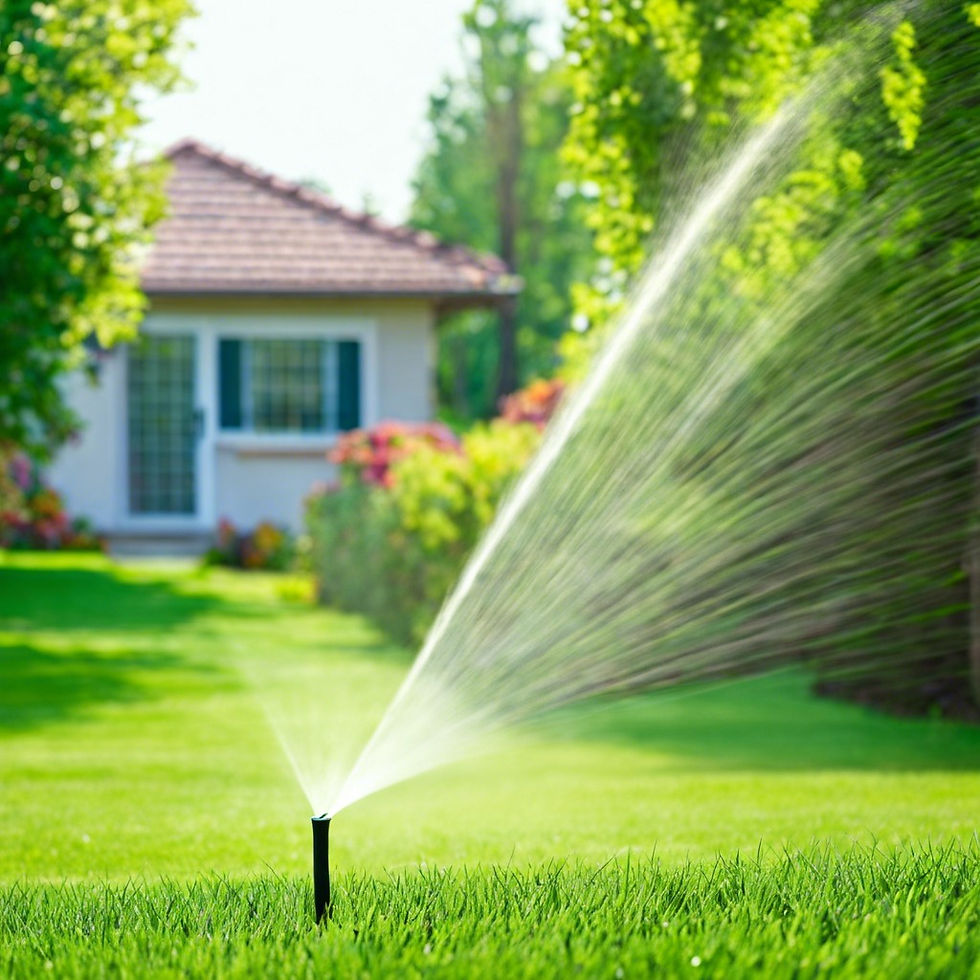"Save Water with Improved Irrigation Designs: A Look at Sprinklers and Drip Systems"
- Athom Designs

- Dec 25, 2024
- 4 min read
The imminent threat of water scarcity intensifies the urgency to develop and adopt Improved Irrigation Designs. These designs refer to innovative and efficient watering systems that sustain agricultural needs while minimizing water wastage. The invaluable importance of water reservation stems from the alarming acceleration of global water depletion, which poses a significant challenge to sustainable agriculture. Hence, a thorough understanding of various irrigation systems, including their mechanics, advantages, and shortcomings, becomes crucial. This paper presents detailed insights into two of the most common irrigation systems—sprinkler and drip—and evaluates them for their effectiveness and potential for water conservation. Few Pointers shared by Reeta, Our Lead Irrigation System Designer at www.athomdesigns.com
Sprinkler Systems: An Overview
Sprinkler systems, long hailed as a standard in irrigation, function through a network of pipes which deliver and distribute water to the landscape. Driven by high water pressure, these systems spray water over the area, mimicking the effect of rainfall. Sprinklers are particularly advantageous due to their ability to cover vast expanses of land and offer uniform water distribution. Despite these merits, traditional systems run the risk of water wastage due to overspray, wind drift, and evaporation.
Drip Irrigation Systems: An Overview
The mechanics of drip irrigation revolve around slowly delivering water directly to the plant’s roots. This system uses a network of tubes, emitters, and valves to distribute water, negating the chances of overspray or evaporation. The prime benefits of drip systems are efficiency and precision, with increased yields recorded in various case studies. However, these systems can often be complex to install and manage, and neglect in system maintenance can clog emitters leading to reduced functionalities.
Comparison of Sprinkler Systems vs Drip Systems:
A key differentiator between sprinkler and drip systems lies in the gross water usage and subsequent savings. Drip irrigation systems typically use 20-50% less water than traditional sprinklers due to targeted irrigation. Advancements in system designs have introduced features like rain sensors and smart timers, further accentuating water savings and ensuring efficient water use.
Practical Applications & Case Studies
Across the agricultural world, there is increasing adoption of both improved sprinkler and drip irrigation systems. Farms are undertaking an audit of their irrigation design to optimize water usage, with companies like athomdesigns.com offering professional assistance. Success stories range from vast vineyards in Spain reducing water usage by 25%, to small vegetable gardens in Australia increasing their yield by 40%.
Overview: Water Wastage in Traditional Irrigation:
Traditional irrigation, be it through sprinklers or drip systems, has long been contributing to water wastage. In sprinklers, oversprays and wind misdirection lead to about 50% of wastage, while in drip irrigation, the lack of system maintenance and user knowledge also contribute to significant water loss.
Detailed Insights into Improved Sprinkler Systems:
Modern sprinkler systems have been designed with a sharp focus on improving water efficiency, be it through high-efficiency nozzles or smart sprinkler controllers. With smart technology and digital scheduling, these improved systems are innovative tools for saving water.
In-depth understanding of Improved Drip Irrigation:
Innovations in drip irrigation designs also aim at reducing water wastage. Systems are being equipped with features like root zone watering, pressure compensating drippers, and automated maintenance reminders which maximize water usage.
Case Studies of Farms Using Improved Systems:
Successful implementation and tangible water savings across various farms demonstrate the potency of these modern irrigation designs. From large-scale wineries to small organic farms, newer systems are revolutionizing the way we irrigate, ultimately contributing to water conservation.
Encourage Implementation:
Improved irrigation systems are not only a solution to the ongoing water crisis but also a means to reduce expenditure on water bills - highlighting their cost-effectiveness. These systems also play a significant role in environmental conservation by reducing the strain on water resources.
Traditional Irrigation Methods & Their Shortcomings:
Traditional sprinklers and drip systems, despite their widespread use, have significant shortcomings. They often lead to overwatering - resulting in poor plant health, water wastage, and higher utility bills.
Technological Improvements in Sprinkler Systems:
Contemporary sprinkler designs are highly dynamic, versatile, and efficient. Features like rotator sprinklers, soil moisture sensor-based watering, and web-based scheduling all maximize water savings.
Technological Improvements in Drip Systems:
Modern drip systems offer unprecedented precision & efficiency. New age components like pressure regulators, backflow preventers, and automated filtration systems enhance system functionality and save more water.
Comparing Sprinklers & Drip Systems' Efficiency:
A comprehensive comparison of sprinkler and drip systems illustrates that each has its own strengths and can be selected based on specific needs. Choosing the right system is crucial to effective irrigation and can be accomplished with a rigorous audit of the irrigation design.
It is imperative to adopt efficient irrigation practices and conservation methods to sustain our water resources. Take action today for a sustainable tomorrow.
In conclusion, it is apparent that improved irrigation designs, both in sprinkler and drip systems, play a crucial role in water conservation. Both systems, with their unique mechanics and benefits, offer distinctive advantages and some drawbacks to consider. However, through comparison, it can be deduced that improvements in design lead to significant water savings in both models. They find practical applications in a range of scenarios, elucidated through various case studies. Therefore, it's critical for the individual user, or larger entities, to adopt these advanced irrigation methods to wisely use water resources. I would personally recommend further exploration and embracing of these systems for their undeniable benefits in saving water.
.png)








Comments